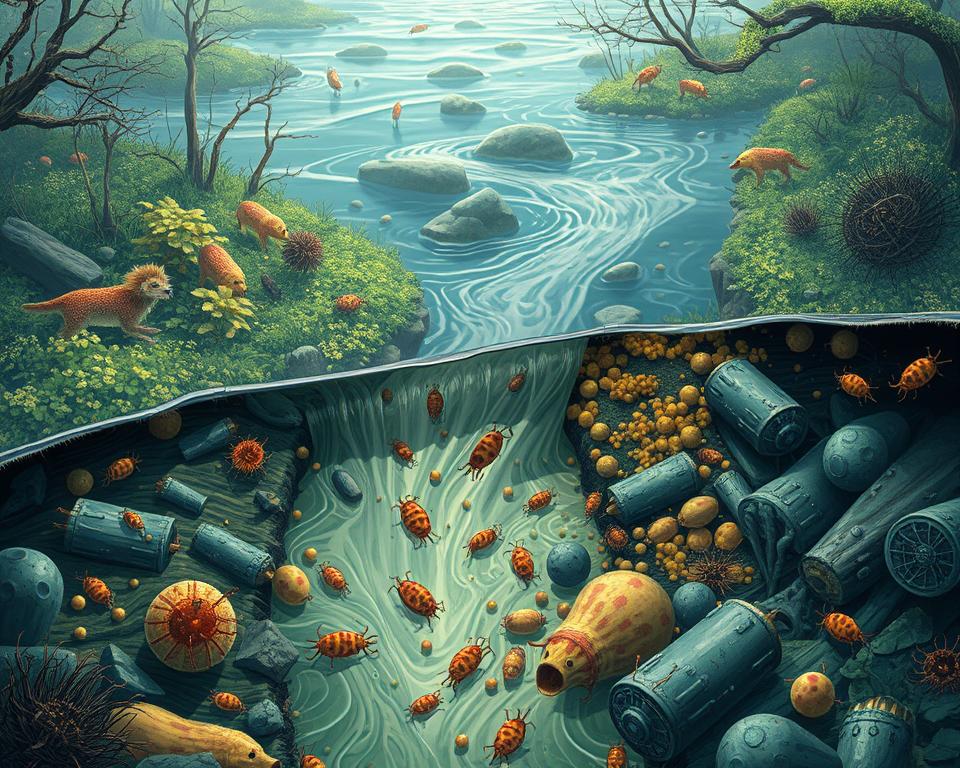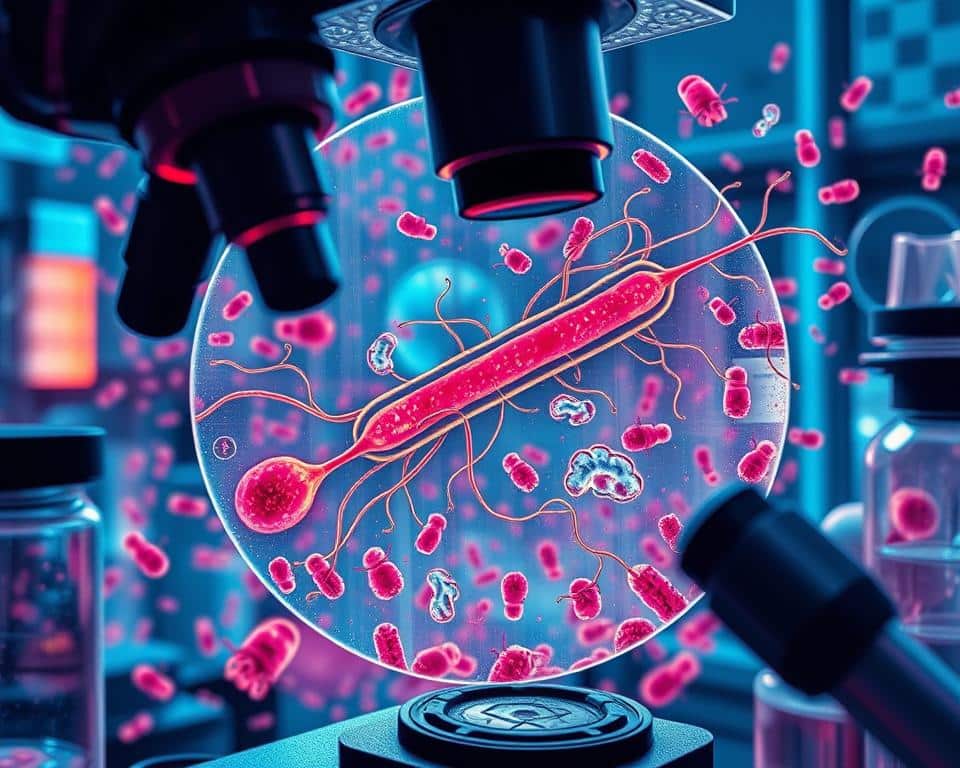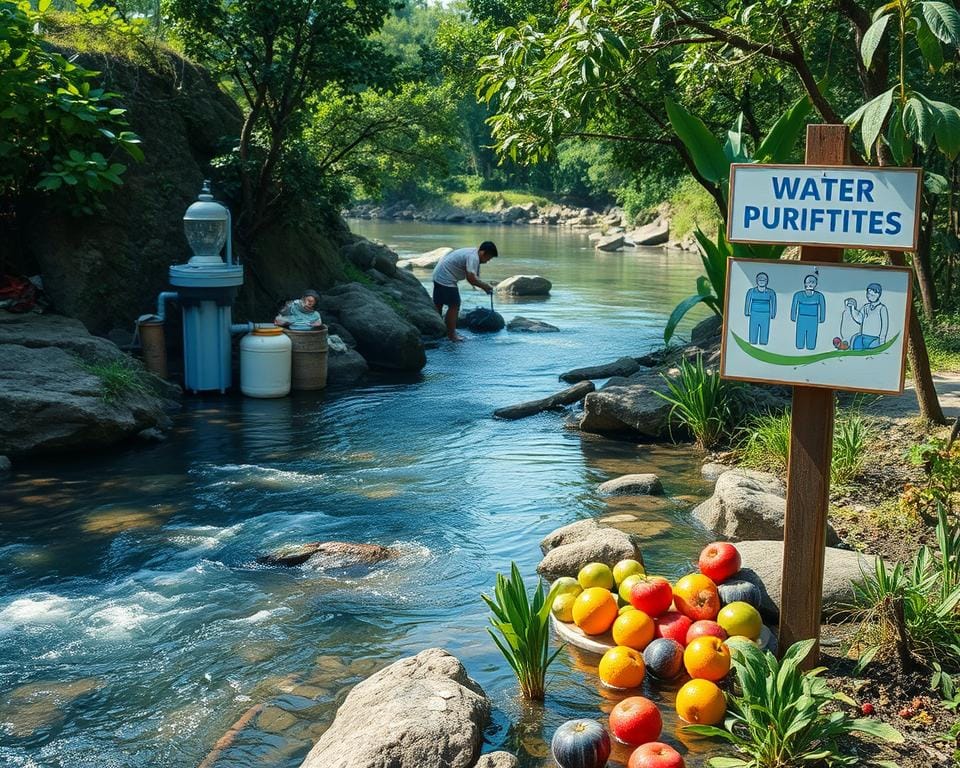Every year, waterborne diseases impact millions around the globe. In the United States, about seven million get sick from these diseases yearly. This leads to 120,000 people going to the hospital. It shows how vital it is to know about these risks and protect ourselves.
People can get these illnesses in simple ways. For example, by drinking water that might not be clean. Or, through fun water activities. Dysentery alone causes 165 million illnesses worldwide, including 450,000 in the U.S. Yet, many don’t know about the dangers of waterborne illnesses like cholera, typhoid fever, and norovirus.
To fight this issue, it’s important to know how these diseases spread. And, to learn how to prevent them. Making sure our drinking water is safe and teaching everyone about the dangers is key. This article will look at the top five waterborne diseases, where they come from, the symptoms, and how we can avoid them.
Understanding Waterborne Diseases
Waterborne diseases come from pathogens in water like bacteria, viruses, and parasites. These diseases are a big health risk, especially for kids, the elderly, and those with weak immune systems. In the US, over 7 million people get sick from these diseases each year. This costs the healthcare system more than $3 billion.

What Are Waterborne Diseases?
These diseases spread by drinking or touching dirty water. They are caused by a variety of pathogens. These include bacteria, viruses, protozoa, and parasites. Even with better water treatment, these germs still pose a danger to public health.
Common Sources of Infection
The main ways people get these diseases include drinking contaminated water and swimming in dirty places. Germs in water can be swallowed or get through the skin. The top sources of contamination include:
- Improperly treated city water
- Private wells without good filters
- Sewage spills and runoff from farms
- Swimming pools and hot tubs that aren’t clean enough
- Wild water contaminated with waste
Contagion and Symptoms
Waterborne illnesses can spread in different ways. You can get sick by drinking or touching contaminated water. Or, you can catch it from another person, touching the same things, or through the air. The symptoms depend on the germ but often include tummy problems like diarrhea, throwing up, and cramps. You can also get breathing problems, skin infections, or brain issues. It’s important to recognize and treat these illnesses quickly.
The WBDOSS helps by tracking waterborne disease outbreaks. This helps health officials fight these diseases better. Knowing how these illnesses spread can help us keep ourselves and our communities safe.
| Prevention Efforts | Impact |
|---|---|
| Maintaining and updating water system infrastructure | Reduces contamination risks and ensures safe drinking water |
| Supporting disease tracking and prevention work | Enhances early detection and response to waterborne outbreaks |
| Developing burden estimates by water type | Improves understanding of specific waterborne disease risks |
| Encouraging compliance with regulations and best practices | Promotes safer water usage and reduces pathogen exposure |
Typhoid Fever: Causes, Symptoms, and Prevention
Typhoid fever is a big health issue, affecting over 9 million people each year across the globe. It mainly hits areas where clean water is scarce and sanitation is poor. Knowing how Salmonella typhi causes illness and its symptoms is key to fighting it.
Causes and Transmission
Typhoid fever spreads through a bacteria found only in humans. It moves from person to person through contaminated food or water. Flies, dirty hands, feces, and objects can carry the bacteria too. This disease is more common in places without clean water or good toilets.

Lately, some types of this bacteria do not get killed by antibiotics. This makes treating typhoid fever harder. Things like where you are or the weather can also raise your chances of getting sick.
Recognizing Symptoms
After catching the bacteria, signs of typhoid fever can take 6 to 30 days to show. Symptoms include a long-lasting fever, feeling weak, not wanting to eat, a headache, feeling unwell, and stomach pain. Seeing these signs early is important for getting the right treatment fast. Some people might also have stomach problems, making the illness worse.
Prevention Measures
Stopping typhoid fever from spreading is crucial. Getting a vaccine is very effective, especially in places where typhoid is common. Vaccines have helped reduce the number of sick people. Washing hands well and handling food safely can also help prevent the disease.
Putting money into better water systems and toilets is also important. These steps have made a big difference in lowering cases of typhoid in the past. Keeping things clean and getting vaccinated are both necessary to stop the spread of the disease.
So, knowing how typhoid spreads, spotting the signs early, and taking steps to prevent it, including getting vaccinated, can help fight this dangerous illness.
Cholera: What You Need to Know
Cholera is a dangerous diarrheal disease caused by infection with Vibrio cholerae. It can cause rapid dehydration and even death in a few hours if not treated. It’s important to know about cholera to prevent and treat it effectively.
Understanding Cholera
Cholera usually spreads through water and food that’s contaminated. Every year, 1.3 to 4 million people get cholera worldwide. Between 21,000 and 143,000 people die from it each year. Poor sanitation and lack of clean water make it worse, especially in developing countries. Thankfully, you can’t easily catch cholera from someone else.
Symptoms and Risks
Cholera symptoms vary from mild to very bad. About 10% of people who get infected will have severe symptoms like watery diarrhea, vomiting, and leg cramps. This can lead to a fast loss of body fluids, causing dehydration and shock. Getting the right treatment quickly is important. With proper care, fewer than 1% of people should die from cholera. People in places with unsafe water, bad hygiene, and poor sanitation are most at risk.
Prevention Strategies
To prevent cholera, we need several strategies. It’s essential to have clean water, good sanitation, and hygiene habits. Here are ways to lower your risk:
- Wash your hands with soap and water before eating and after using the bathroom.
- Drink and use safe food and water—either treated or boiled.
- Throw away human waste properly to stop it from contaminating water sources.
- Get vaccines like Dukoral®, Shanchol™, and Euvichol-Plus®. You need two doses for them to work.
- Water softener repair can also improve drinking water quality, reducing cholera risk.
In conclusion, beating cholera takes understanding Vibrio cholerae and the right prevention methods. Quick treatment and vaccines are key in fighting this life-threatening disease.
Giardiasis: A Common Intestinal Infection
Giardiasis is an important gut infection caused by Giardia lamblia. It impacts over 1 million people in the U.S. every year. Kids are more likely to get this sickness than adults.
Cause and Mode of Transmission
Giardia lamblia cysts cause giardiasis when eaten. These cysts come from sources like lakes and untreated water. Even a few germs can make you sick. People and animals with the infection spread it via contaminated poop. This shows why clean habits and safe drinking water are vital.
Symptoms to Watch For
Not all infected with giardiasis show symptoms. About half don’t. For others, symptoms start 1 to 2 weeks after exposure. Symptoms often include diarrhea, stomach cramps, bloating, and nausea.
These signs can last from two weeks to six weeks or more without treatment. Dehydration is a big worry, especially for kids and the elderly. It can make the disease worse. Sometimes, giardiasis can cause long-term stomach problems or even chronic fatigue syndrome or reactive arthritis.
Prevention Techniques
Preventing giardiasis is key since there’s no vaccine. Here’s how to avoid getting Giardia:
- Handwashing: Always wash your hands with soap and water, especially before meals and after the bathroom or touching animals.
- Water Treatment: Boiling water kills Giardia. Boil water from natural sources for at least one minute. If you’re up high (over 6,500 feet), boil for three minutes.
- Safe Sex Practices: Staying away from oral-anal contact can lower your risk of giardiasis.
- Food Safety: Rinse fruits and vegetables well. Also, steer clear of possibly contaminated food and drinks.
Following these steps greatly lowers your chances of giardiasis. Getting treated early and effectively is crucial to avoid serious health issues from giardiasis.
Conclusion
We’ve learned a lot about diseases that come from water. It’s clear we need to know more about waterborne disease awareness and health protection. Between 2015 and 2020, there were 214 disease outbreaks linked to water in 28 states. This shows these diseases are still a big concern.
Diseases like Typhoid Fever, Cholera, and Giardiasis show why we must understand how they spread. We must know the symptoms and how to use safe water practices. Bugs like Legionella and norovirus cause many of these illnesses. They even lead to hospital stays and deaths. For example, Legionella caused 98% of the outbreaks from biofilms, affecting many.
By keeping clean, handling food and water safely, and spotting symptoms early, we can lessen these risks. Issues range from gut diseases linked to wells to outbreaks in homes from biofilms. Acting early is key. As we work to make water and health better, using public health watch and strict water treatment is essential. I urge everyone to stay aware and practice safety every day. Check out this comprehensive guide for more about water and staying safe.

